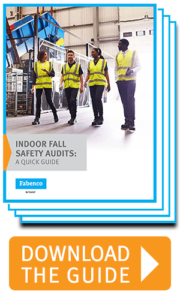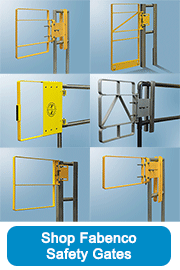
The sound of moving equipment, workers shifting products, and loading vehicles moving in and out can be music to any manager’s ears—after all, more activity means business is booming. However, the buzz of activity at your warehouse also signifies increased risks, including injury caused by fall accidents. As workers rush to complete orders and keep up with increasing pressure, they may slip, fall, or make other mistakes that lead to fall incidents. Likewise, new or temporary hires and more crowded workspaces can make the situation even more tenuous. Ensuring that your warehouse is ready for action with the right fall protection equipment is the best way to keep your workers safe and your warehouse productive.
Types of Fall Accidents in a Warehouse
Thanks to the nature of the various elevations, surfaces, and (unfortunately) the ignorance of safety rules, warehouses can present lots of opportunities for slips and falls. There are three types of fall accidents likely to happen:
1.) The Same-Level Fall:
As the name implies, these falls happen on the same level. They can result from uneven footways, curved surfaces, or encroached building fixtures. They are also commonly caused by wet surfaces due to water, grease, and other spilled liquids, merchandise and equipment recklessly placed on the floor, poorly lit warehouses and corridors, floor holes, or poorly treaded shoes. Keep workspaces clean and free of obstruction and consider handrails as a smart fall protection equipment option.
2.) Elevated Falls:
These occur when a worker falls from a higher elevation surface to another below. These types of falls are common on stairways, mezzanines, loading docks, and ladders, and are some of the most dangerous. OSHA requires employers to provide fall protection equipment in any setting where a worker may fall 4 feet or more to a lower level. On top of guardrails, you also may want to consider safety harness lanyards, as well as loading dock safety gates or other self closing gates to control access to these areas.
3.) Swing Falls:
These are specific to falls that occur while the worker is attached to a fall arrest system when the point of attachment is not directly over the worker’s head. This results in a fall that can swing into an object or wall, resulting in serious injury. Swing falls can be prevented by making sure the safety harness lanyards are always overhead in a setting where collision may happen.
OSHA Standards and Warehouse Safety

Duty to Have Fall Protection: Sections 1910.28 and 1926.501 set forth requirements for employers to provide fall protection systems, and detail where and how you need to do it.
Guardrails: Sections 1910.29(b) and 1926.502 detail the specifics needed when installing guardrails, including weight and height requirements.
Ladders: Section 1910.23(a) covers all ladder requirements except for those used in emergency operations or those designed into or is an integral part of machines or equipment.
Stairways: Section 1910.25(a) covers all stairways (including standard, spiral, ship, and alternating tread-type stairs), except for articulated stairs, scaffolds, stairs designed into machines or equipment, and stairs on self-propelled motorized equipment. There are specific requirements for rails and self closing gates installed on stairways as well.
Personal Fall Protection Systems: Section 1910.140(a) reviews the performance, care, and use criteria for all personal fall protection like safety harness lanyards.
What Can You Do to Prevent Slip and Fall Hazards at Your Warehouse?
There are several things you can begin implementing right now to prevent fall accidents in your warehouse and get it up-to-speed:
Remove Empty Pallets and/or ensure that they’re within required boundaries away from all traffic. If a pallet is broken, the broken edge could potentially snag a worker’s clothes and result in a trip. Ensure that all the pallets are in good shape, repair or replace them if not, and keep them out of high traffic zones.

Install Better Lighting: It’s a lot easier to trip when your vision is compromised by poor lighting. Ensure all sections of the warehouse have sufficient lighting, especially the walkways, stairways, and any area where a worker may come in from bright outdoor light (like loading docks).
Install Warning Signs: If you have wet surfaces, elevated workspaces and walkways, or any other hot spots, install warning signs to serve as a visual reminder to employees to work with caution.
Keep Your Gates Closed When Not in Use: Whether it’s your loading dock safety gates, access gates, or other type of safety swing gates, make sure they are closed after every use to ensure protection. (Self closing gates can help remove human error from this equation.)
Fix Your Floors: Repair any uneven flooring (including worn down or curling-up treads).
Install Passive Fall Prevention Systems: Workers working on elevated surfaces or near holes need fall protection equipment. Install loading dock safety gates to prevent accidents on busy docks, guardrails along elevated walkways and mezzanines, and access gates around stairways, ladders, and hatches.
Invest in Personal Fall Arrest Systems (PFAS): For areas where guardrails are impractical, or for manlifts and other equipment that puts your workers at height, be sure to provide safety harnesses, lanyards, and an appropriate anchorage point.
Train Workers: Make sure all employees are aware of fall hazards and how to work effectively around them to avoid accidents. Also, be sure employees are trained on safety harness lanyards or other personal protective equipment as necessary.
In Warehouses, Safety Needs to Be #1
While productivity is of course important, protecting your workers should be your number one priority. As warehouse activity increases, this only becomes more important. And considering productivity comes to a screeching halt if a fall does occur, it’s hard to argue the value in skimping on fall protection equipment. Fortunately, the right kind of fall protection can allow productivity to remain high while keeping your workers safe, even when things get busier. Don’t wait until your workspace gets jammed – the right time to explore your fall protection options is now. Want to learn where to begin? Give us a call today.





